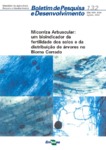Por favor, use este identificador para citar o enlazar este ítem:
http://www.infoteca.cnptia.embrapa.br/infoteca/handle/doc/569103Registro completo de metadatos
| Campo DC | Valor | Lengua/Idioma |
|---|---|---|
| dc.contributor.author | CORREIA, C. R. M. de A. | pt_BR |
| dc.contributor.author | REATTO, A. | pt_BR |
| dc.contributor.author | MARTINS, E. de S. | pt_BR |
| dc.contributor.author | SILVA, E. M. da | pt_BR |
| dc.contributor.author | CALDAS, L. S. | pt_BR |
| dc.contributor.author | FAGG, J. F. | pt_BR |
| dc.date.accessioned | 2011-07-08T11:47:41Z | - |
| dc.date.available | 2011-07-08T11:47:41Z | - |
| dc.date.created | 2005-11-21 | pt_BR |
| dc.date.issued | 2004 | pt_BR |
| dc.identifier.citation | Planaltina, DF: Embrapa Cerrados, 2004. | pt_BR |
| dc.identifier.uri | http://www.infoteca.cnptia.embrapa.br/infoteca/handle/doc/569103 | pt_BR |
| dc.description | RESUMO: A grande variedade de fitofisionomias existentes no Bioma Cerrado tem sido associada a diferentes fatores ambientais como clima, relevo, geologia, entre outros. O fator solo exerce influência fundamental nessa diversidade ambiental. As suas características químicas, físico-hídricas e biológicas formam um complexo de inter-relações, muitas vezes, difícil de analisar. A atuação do componente biológico nos solos de Cerrado ainda é pouco estudada. Das populações que compõem a microbiota, as micorrizas são reconhecidamente de grande importância nos ambientes oligotróficos ou sujeitos a qualquer tipo de restrição. Haja vista a ampla ocorrência de solos distróficos no Cerrado, pode-se supor que as micorrizas têm importante papel na composição das comunidades vegetais naturais sobre esses solos. Com o objetivo de identificar a importância das micorrizas na distribuição de espécies arbóreas e melhor compreender a associação entre micorrizas e fertilidade do solo na região do Bioma Cerrado, realizou-se o presente trabalho. Foram analisados um Cerrado Stricto Sensu sobre o solo distrófico e uma Mata Semidecídua sobre solo eutrófico. Na comunidade do Cerrado houve, em média, 16,6% de colonização micorrízica nas raízes e na Mata Semidecídua 8,3%. As densidades de morfotipos de fungos e de esporos também foram maiores no solo distrófico. Baseado nas características químicas, físico-hídricas dos solos e na estrutura florística da comunidade, procurou-se discutir a diferença entre esses valores. Além da maior fertilidade do solo da Mata Semidecídua, sugere-se que as características físico-hídricas desse solo devam ter contribuído para a menor colonização em relação à comunidade do Cerrado Stricto Sensu. ABSTRACT: The great variety of existent phytophysionomies in the Cerrado Region hás been associated to different environmental factors as climate, relief, geology and others. The soil factor has fundamental influence in this environmental diversity. Its chemical, physical-hydrological and biological characteristics form complex interrelations, many times, difficult to analyse. The performance of the biological component in the soils of Cerrado is still not well studied. Among the populations that compose of the soil microbiota, the micorrhizas have a great importance in oligotrophic encironments. Considering the wide occurrence of dystrophic soils in the Cerrado, it can be supposed the the mycorrhizas have an important role in the natural plant communities of these soils. The objective of the present work was to identify the importance of the mycorrhizas in the distribution of tree species and understand the assciation between mycorrhizas and fertility of the soil in the Cerrado Region. Two communities were analyzed: Cerrado Sensu Stricto over dystrophic soils and Semi-Deciduous Forest over eutrophic soils. The results showed that the first community possessed and average 16,6% of mycorrhizal colonization and the second possessed an average 8,3% of mycorrhizal colonization. The densities of morphotypes of mushrooms and of spores were also larger in the dystrophic soil. According to the chemical and physical-hydrological characteristics of the soils and of the communities floristic structure, tried to discuss the difference among these values. Besides the largest fertility of the soil of the Semi-Deciduous Forest, the physical-hydrological characteristics of this soil might have contribuited to the smallest colonization in relation to that observed in the Cerrado Sensu Stricto community. | pt_BR |
| dc.language.iso | por | pt_BR |
| dc.relation.ispartofseries | (Embrapa Cerrados. Boletim de Pesquisa e Desenvolvimento, 132). | pt_BR |
| dc.rights | openAccess | pt_BR |
| dc.subject | Colonização micorrízica | pt_BR |
| dc.subject | Solo eutrófico | pt_BR |
| dc.subject | Solo distrófico | pt_BR |
| dc.subject | Soil mycorrhizae | pt_BR |
| dc.subject | Mycorrhizal colonization | pt_BR |
| dc.subject | Eutrophic soils | pt_BR |
| dc.subject | Dystrophic soils | pt_BR |
| dc.title | Micorriza arbuscular: um bioindicador da fertilidade dos solos e da distribuição de árvores no bioma cerrado. | pt_BR |
| dc.type | Folhetos | pt_BR |
| dc.date.updated | 2011-07-08T11:47:41Z | pt_BR |
| dc.subject.thesagro | Cerrado | pt_BR |
| dc.subject.thesagro | Microbiologia do Solo | pt_BR |
| dc.subject.thesagro | Micorriza | pt_BR |
| dc.subject.thesagro | Solo | pt_BR |
| dc.subject.nalthesaurus | microbiology | pt_BR |
| dc.format.extent2 | 38 p. | pt_BR |
| riaa.ainfo.id | 569103 | pt_BR |
| riaa.ainfo.lastupdate | 2009-10-27 | pt_BR |
| Aparece en las colecciones: | Boletim de Pesquisa e Desenvolvimento (CPAC)  | |
Ficheros en este ítem:
| Fichero | Descripción | Tamaño | Formato | |
|---|---|---|---|---|
| bolpd132.pdf | 626,63 kB | Adobe PDF |  Visualizar/Abrir |









